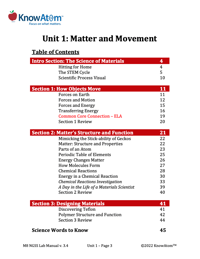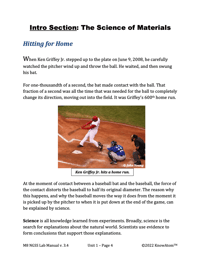In this lesson, students use the phenomenon of how concrete is made to support their analysis of how chemical reactions produce new substances with different properties.
In this unit, students are introduced to matter and energy as they learn about how scientists and engineers design materials with specific properties to address a wide range of societal needs. They focus on the basic structure of matter, and how energy changes matter in physical and chemical changes. In this lesson, students focus on the role of energy in changing matter during a chemical reaction phenomena between two substances. This page provides an overview extract of this lesson.
The science background gives teachers more detailed information on the phenomena students explore. Here is an excerpt from the science background section on chemical reactions.
In order to understand how scientists can create new materials with specific properties designed for a particular purpose, scientists need to understand the relationship between matter and energy because matter can only change when enough energy is present.
For example, all matter has a form of kinetic energy called thermal energy, which is the motion of atoms and molecules in a substance or object as its temperature increases. The faster that atoms and molecules move, the more thermal energy they have and the warmer they become. The amount of thermal energy present in a substance determines whether that substance is a solid, liquid, or gas because thermal energy changes the motion of molecules.
However, it doesn’t change the chemical structure of the substance. For this reason, a change of state is considered a physical change. Whether you freeze or boil a cup of water, the water molecules are still water molecules.
All matter also has a form of potential energy that is stored in the bonds holding together atoms and molecules. This is called chemical energy, and it is what allows new molecules and compounds to form. Understanding the structure of atoms and how they combine is an important part of materials science because each kind of material has the properties it does because of the number and kind of atoms that make it up. A molecule is made up of two or more atoms bonded together. To bond means to join together.
For example, oxygen is made up of oxygen atoms bonded together, so it is a molecule. Water (H2O) is a molecule because it is made up of two hydrogen atoms and one oxygen atom bonded together. Water, like gold, is also an example of a pure substance because it is made up entirely of one kind of atom or molecule that has distinct properties that do not vary from sample to sample.
With only three atoms, water is a small molecule. Other molecules can be much larger. One molecule of vitamin C (C6H8O6) is made up of 20 atoms: 6 carbon atoms, 8 hydrogen atoms, and 6 oxygen atoms. Some molecules are made up of many thousands of atoms bonded together.
Molecules are formed as a result of a chemical reaction between two or more atoms. In a chemical reaction, the atoms that make up the original substances are rearranged into new substances that have different properties from the original substances.
For example, at normal room temperature, the elements oxygen and hydrogen are both gasses. When hydrogen and oxygen bond in a molecule of water, they change into a liquid instead of a gas at room temperature. These changes are chemical changes because they rearrange the chemical structure of the substances through a chemical reaction.
In any chemical reaction, the atoms and molecules that interact together are called reactants. The atoms and molecules produced by the reaction are called products.
Together, the reactants and products form a system. The environment is everything else, including the air or any substance mixed with the reactants. It’s important to note here that reactants are sometimes dissolved in other substances, such as water. The dissolving substance (such as the water) is called the solvent. When this occurs, the solvent in which the reactants are dissolved is part of the environment.
The total number of atoms does not change in a chemical reaction. Because of this, the mass of any one element at the beginning of a reaction will equal the mass of that element at the end of the reaction. This is called conservation of mass, which is the theory that states that matter is never created or destroyed. This means that the more reactants you add to the chemical reaction, the more products will form.
In this lesson, students use the phenomenon of how concrete is made to support their analysis of how chemical reactions produce new substances with different properties.

Prepared hands-on materials, full year grade-specific curriculum, and personalized live professional development designed to support mastery of current state science standards.
Misconception: After a reaction, the product is a mixture made up of the old substances, which still exist, achemical nd therefore is not a new substance.
Fact: Chemical reactions produce new substances because they break down the molecules that make up the reactants and rearrange them to form new substances.
Atom : the smallest piece of matter that has the properties of an element; a combination of three subatomic particles: protons, neutrons, and electrons
Chemical change : a change that rearranges the chemical structure of a substance through a chemical reaction
Chemical energy : a form of potential energy that is stored in the bonds holding together atoms and molecules
Chemical reaction : a process that rearranges the atoms of the original substance into a new substance that has different properties from the original substance
Element : a substance made up entirely of one kind of atom
Endothermic : a process that absorbs energy from the environment
Exothermic : a process that releases energy into the environment
Matter : everything that has mass and takes up space
Molecule : a combination of two or more atoms bonded together
Physical change : a change that does not affect the chemical structure of a substance
Scale : the size, extent, or importance (magnitude) of something relative to something else
Thermal energy : the motion of atoms and molecules in a substance or object as its temperature increases

Mimicking the Stick-ability of Geckos
On a cold December day, an engineering student named Elliot Hawkes acted like a slow-motion Spiderman. He slowly climbed up a glass wall behind his science lab. He was able to stick to the glass because he was testing a new kind of material that was attached to his hands and feet.
The material used by Hawkes to scale the glass wall was designed by humans to mimic gecko feet. Geckos are lizards that can stick to almost any surface they walk on. They can run up smooth walls and across the ceiling without falling. This “stickability” is called adhesiveness. It is a property that gecko feet, glue, and tape all share.
How Geckos Stick
Geckos are able to stick to most surfaces because of their unique feet. Their feet are lined with millions of tiny hairs, called setae. The setae create an attraction between the gecko’s feet and the surface. Unlike adhesives such as glue or tape, however, the gecko’s sticky feet can attach and detach from the surface easily. This means the adhesiveness doesn’t have to be permanent, like glue.
Scientists are so intrigued by the gecko’s adhesive feet that they have been trying to mimic it, thinking about applications as common as wigs and toupees that remain in place, and as cutting edge as robots that can catch space junk (such as satellites that are no longer working).
Matter: Structure and Properties
Before a materials scientist like Elliot can design a new synthetic material or choose a natural resource for a specific function, they have to have a basic understanding of matter—anything that has mass and takes up space.
To understand why a material has the properties it does, scientists begin with the atoms that make it up. An atom is the smallest piece of matter that has the properties of an element—substances that are made up entirely of one kind of atom.
Aluminum foil is a synthetic material because it is created by humans. However, it is made from aluminum metal, which is a natural resource. Aluminum metal is made up of billions of aluminum atoms.
Atoms are so tiny that we cannot see them without special instruments. Because of this, scientists use scale to understand how atoms relate to everyday objects.
Scale is the size, extent, or importance (magnitude) of something relative to something else. For example, think about all of the atoms that make up a grapefruit. If each atom were the size of a blueberry, the grapefruit would be the size of Earth.


Parts of an Atom
Atoms themselves are made up of smaller particles. These particles include protons, neutrons, and electrons. These smaller particles are much smaller than the atom itself.
The protons and neutrons group together in the nucleus. If you were to open up the blueberry (representing the atom), the nucleus would be too small to see.
Scale of an Atom’s Parts
If you were to make the blueberry the size of a football field, you would just be able to see the nucleus. It would be the size of a small marble. The nucleus is very dense because it holds all of the atom’s protons and neutrons. Most of the atom’s mass—99.9 percent—comes from the protons and neutrons.
The electrons are in constant motion around the nucleus. However, most of the atom is filled with empty space. There are vast regions of space between each of the electrons and between the electrons and the nucleus.
Scientists use what they know about an atom’s structure to create a scale model of an atom. Scale models are useful for scientists who want to understand the atom as a system, and how the various parts of the atom interact.
Scientists often don’t work with individual atoms because they are too small to see without special instruments. Instead they work with elements, such as a gold bar or helium gas. An element is a pure substance. This means it is made entirely of one kind of atom that has distinct properties that do not vary from sample to sample.
It is the structure of the atoms that make up a substance that give that substance the properties it has. Many of an element’s properties are determined by the number of protons and neutrons its atoms have. Other properties are determined by an atom’s number and arrangement of electrons.
Most materials scientists agree that the single most important event that happened in their field came in 1864. This is when Russian scientist Dmitri Mendeleev put together a chart called the Periodic Table of Elements. This chart arranged all of the known elements according to their properties. When Mendeleev developed the periodic table, there were 63 known elements. His real genius was in predicting that elements existed that hadn’t yet been discovered.
His prediction was correct. There are currently 118 known elements, with the last four added just in 2016. These 118 elements are the only substances needed to make all of the materials that exist. In the human body, there are many billions of atoms, but scientists believe that more than 95 percent of the body is made up of just six elements: hydrogen, carbon, nitrogen, oxygen, phosphorus, and calcium.
The first 94 elements are believed to occur naturally. The rest are synthetic. Most of the elements that have been created last only seconds, at most, before breaking apart into smaller elements. Scientists are continuing to search for new elements.
For the hands-on activity in this lesson, students analyze the observable properties and thermal data produced by the combination of two substances to determine if the phenomena of a chemical reaction occurred. Students explore the phenomena of how the structure of matter changes during a chemical reaction, resulting in new and different properties of the product without creating or destroying mass in the process.
KnowAtom incorporates formative and summative assessments designed to make students thinking visible for deeper student-centered learning.
.png?width=297&height=347&name=Screenshot%20(73).png)
Standards citation: NGSS Lead States. 2013. Next Generation Science Standards: For States, By States. Washington, DC: The National Academies Press. Neither WestEd nor the lead states and partners that developed the Next Generation Science Standards were involved in the production of this product, and do not endorse it.